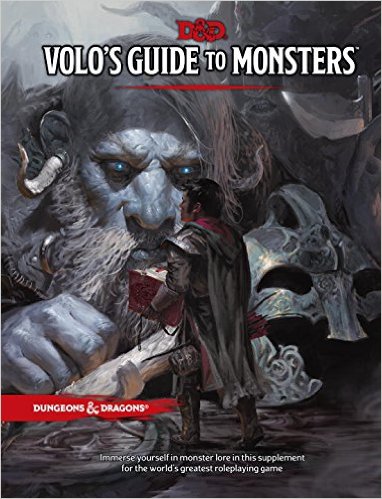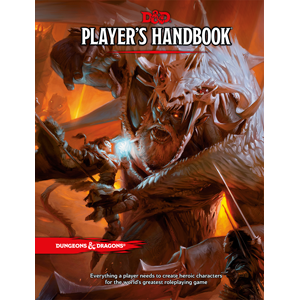 I’ve played Dungeons and Dragons for 12 years, DM’ed various campaigns for the last 8, and while I’ve heard of alluring storylines and tested the waters of other systems (specifically, Classic WoD and Star Wars d20), I’ve always come back to D&D. I cut my teeth on D&D 3.5, with a party of 3 players, and a library of about 50 books between us (including all 5 Monster Manuals, and the Draconomicon). During the days of 3.5, there was so much reading material (in the form of splatbooks) that I grew to appreciate any rule book which helped to develop the narrative, state of the world, or flesh out a particular region. “Volo’s Guide to Monsters” is like a 5e narrative dream come true. 1. Cheeky Sidenotes Break up the Sections - Between the competing narratives of Volo and Elminster, it’s hard to not chuckle to yourself while perusing the pages of this manual-cum-Grimm-Tale. That’s not really a word, or a portmanteau, I just made it up. Anyway. Starting at the beginning (as all good stories do), you are introduced to two competing, slightly egotistical guides who help color what can otherwise be a procedural book for DM’s. Their notes, like stray fragments of parchment shoved between the pages, lend either a word of warning to adventurers, a funny tale, or a different perspective on the beast currently being discussed. It makes the whole book feel more like reading an adventure, than a rule book. 2. It Is So Much More Than a Monster Manual – In addition to the Bestiary – a fabulous collection of macabre species, some new, some old, some resurrected from previous editions – there are two other sections to the book. Volo, Elminster, and Wizards of the Coast, took their time to really delve boots-first into the history, society, inner workings, and motivations of some of the most iconic creatures (and end-boss options) D&D has to offer. In the Monster Manual proper, only Dragons truly got the “full work up” with ecosystems, motivations, and more than just the stat block and standard 3-6 paragraph write up. I live in those paragraph write-ups. They help fuel my curiosity and creativity to uncover new ways to blend creature alliances, shape story hooks and future plot lines, and really enrich the world that my PC’s really live in. 3. New Playable Races - I can neither confirm nor deny if I squealed loudly at the discovery of entire pages dedicated to new playable races, with their societies, quirks, and history all mapped out and ready to use in character creation. WoTC has been releasing a steady stream of Unearthed Arcana, monthly PDF’s with races, classes, and class sub-types, with the distinct disclaimer that they had not been play-tested, might not yet be balanced, and are to be used at the DM’s discretion. There were no repeats of any of the Unearthed Arcana races in Volo’s Guide, and while there was a small disclaimer regarding balance, I’m no stranger to making odd things work. (Did I ever mention the flying Halfling PC I gamed with, Flitz?) These races may not be for the faint of heart, or cautious DM, but I’ve already used a Firbolg Druid as an NPC, because OMG CUTE GIANT NATURE GUY. Okay, end squee. 4. More Artwork for Existing Monsters - If you are a visual-centric person, sometimes a tome heavy in text and light on illuminations can feel like a chore. Stat blocks are easy to pick up, and plunk down into an adventure wherever you need it. But stat blocks all on their own don’t carry the gravitas that a professional picture can. I am a fan of obscuring most of the page, save the image, and showing it to my players, simply stating “This is what you see” and allowing their reactions to fuel the encounter (I don’t need a hype-man, they bring their own hype, man). I’m usually met with sounds of dread, horror, and the occasional shaking of boots. I have grown to appreciate, even enjoy, the temporary dismay of my players, as I know it’ll mean the victory will be all the sweeter for them. 5. New Monsters, Re-Skins, and Resurrections - Originally, I was going to use my final point to mention one monster that truly got me excited to use them in my next session. Maybe Redcaps, tiny Evil Fey in all of their shin-kicking glory? Or Cave Fishers, the Underdark’s wolf spider/scorpion lovechild, with moonshine for blood. Or CAT PEOPLE. Because that’s OFFICIALLY a THING that I ENJOY. A LOT. (No, I did not exclusively play Khajit in Skyrim… I don’t know what you’re talking about…) There are a slew of monsters from previous editions, including some that haven’t seen the light of day since Second Edition, enough to get any fan fired up. But, I don’t have another 797 words available to truly touch on all my favorites, so this sampling will have to suffice. Ultimately, I think Wizards of the Coast have been cranking out incredible supplemental materials since D&D 5e was first released, and I can absolutely appreciate the over-arching narrative they have created through their modules. However, all of those previous purchases were useful to me for the appendices, those little footnotes about new creatures, new items, and ways to help shape my own setting. They were crumbs cast from the loaf I was yearning for. Volo’s Guide to Monsters gave me the full course, with the trimmings, and I can contentedly say that I am satisfied. I can continue to hope, however, that this new narrative direction continues, as I’m bound to hunger for more knowledge again. Angela Daurio has run out of words to type up a more complete biography. She is a Dungeons and Dragons 5e DM and player, with a soft spot for weird creatures, including her cats and her friends.  I get it. Reading the player’s handbook is uninteresting. The rule stuff is for the DM to know. You just want to sit down and play already. Well, suck it up! In order to be a competent role-player, you have to be at least somewhat familiar with the game’s basic mechanics. This means reading at least some of the rules. Too many times have I played with people who have relied on others to tell them how to take even the simplest of actions. I’m not talking about knowing how to do every last thing; leave that to the freaks like me who are obsessed with such rules (shout out to my fellow freaks!). And by all means, if you don’t know how to do something, ask. I fully understand that our hobby is a vast and complicated one. However, you should at least have a rudimentary familiarity with the basics of how to play your character without needing to frequently ask for rules clarification. All material in all RPG core books can be broken down into two categories: reference and reading. Reference material represents the core statistics that make up everything in the role-playing universe and commonly appears in the form of tables, charts, diagrams, lists, or figures. Reference material is not meant to be memorized and players only need to know how to find the relevant chart when looking up certain information (such as how much damage a longsword does, the cone’s radius for burning hands, etc.). Most players are proficient in their use of reference material (5E pun!); indeed, character sheets are just a handy sheet of reference material commonly used by the player. It’s the reading material where some players have issues. These sections make up the majority of most core books (monster manuals excluded) and contain valuable information of which every player should be aware. I’m not saying that you must memorize the reading sections, for that is an absurdly tall order. However, a basic understanding, supplemented by having core books readily accessible while playing, will go a long way in improving everyone’s session. Thankfully for you, in the following sections, I will present three small sections of any player’s handbook that every player should read which will greatly improve their role-playing. I will also reference the page numbers for the D&D 5E Player’s Handbook for anyone currently playing with 5E. 1. Character development [Pages 17-112]. Hold up, I know that looks like a lot of pages, but all you need to read is the 1-2 pages describing your character’s race and the 5-7 pages describing your class. You made it through my first few laborious paragraphs, so 6-9 pages of actually interesting reading shouldn’t prove too difficult. It is vital to know the special traits unique to your race for building and playing your character. Not only does it affect the game’s mechanics but it should also inform how you play your character’s personality. The class description is of even greater importance. It will often contain class-specific actions that you will need to know how to perform as well as background information that will guide your character’s creation and can inform on how you bring their personality to life. I also strongly suggest reading how your character will progress through future levels. Not only does this allow for quicker levelling-up, but it provides players a frame of reference (I’ve got to stop using the word ‘reference’ so much) for how to play your character. Do you want your rogue to take the thief or the assassin archetype? If it’s the former, you could play your character as a happy-go-lucky gold-hog while if it’s the latter you could play them as dark, cunning, and dangerous. Will your ranger be a hunter or a beast master? Such a decision should inform on how he or she views animals. Such knowledge of your class and race not only instructs the player on how to play their character according to the game’s mechanics but also how to think and act like their character would in their fictional world. 2. Using ability scores and skills [pages 173-179]. All RPG systems have character stats, be they Str/Dex/Con/Int/Wis/Cha or something similar. Players need to be aware what each represents and how they can use them. As this is fairly straightforward, most players understand this sufficiently. However, most players lack the knowledge of how to properly use their non-combat skills. For a D&D 5E example, do you know how and when to use investigation vs. insight vs. perception? Yes? Then skip to the next point because you and I are on the same page (handbook pun!). Non-combat skills are definitely not as glamorous as their combat brethren but they are of equal, if not more, importance. I cannot recall how many times members in my group have asked to do something and then, when prompted by the DM for a relevant skill with which to roll, they begin guessing skills which sound potentially relevant (history? Arcana? Survival?). This is especially important in simulationist systems like D&D 3.5 or Shadowrun which provide players with billions of non-combat skills to master (huzzah for Use Rope!). Don’t rely on the DM to tell you which skills you should use in each situation. Be proactive and know what your character can do. 3. Combat actions [pages 189-198]. The mechanics of combat are essential in every role playing system. Understanding the turn order and game mechanics surrounding combat will make the experience of everyone at your game table more fluid and fun. Learning the details of combat can change players from asking ‘can I do such and such?’ to declaring ‘I will do such and such!’ You see the difference there? Such and such is so much more epic in the latter than in the former. Be an exclamation, not a question. Having to frequently break character to ask whether or not you can do something slows down the game for everyone and distracts from the grand saga that is unfolding. Furthermore, characters have many different actions available to them in combat; being aware of everything your character can do makes for much more varied and enjoyable combat situations. For example, isn’t taking the ‘Shove’ action to force your opponent off a 1,000 foot cliff into a shark infested moat of lava alight with hellfire and damnation much more satisfying than just stabbing him to death like you did all those other guys? (Alright, I may have gotten a little bit carried away there). In addition, learning the available actions will also prepare you for anything your foes might do. The DM is often more learned in the rules than the average player, which can give them an edge in combat; take away that advantage! Learn your rules! Goodness knows they can kill us all in more ways than by merely being better at the game than us. Also, there other details important to combat located in this section, such as the importance of creature size, movement and positioning, holding actions, cover mechanics, and hit points to name but a few. Don’t just rely on the DM to notify you of those which apply to you. Bonus reading for spellcasters and other advanced classes- sophisticated mechanics [pages 201-205]. Bonus reading for all you mages and riggers out there! Don’t blame me: you brought this on yourself in choosing a complicated character. Don’t misunderstand me though, it’s the best choice you could have made. I always find myself drawn towards these classes when creating characters; the greater diversity in mechanics supports a character which can be much more adaptable and varied than a ‘hit-it-if-it-moves’ sort of character (not that I’m hating on barbarians, it’s just much more fun to be able to hit it if it moves using fire, ice, steel, lightning, or acid at my leisure, or, even better, to be able to force it to hit itself if it moves). If you play one of these classes, you need to understand how to use their advanced mechanics (i.e. spellcasting in D&D 5E). These will often have important mechanics that can cause these classes to become unbalanced if played incorrectly; these are often very specific mechanics which will only apply to your character. It is not the responsibility of the DM to know how to play your specific class. Again, IT IS NOT THE RESPONSBILITY OF THE DM TO KNOW HOW TO PLAY YOUR SPECIFIC CLASS. If a spell requires components, know what they are and know how to use them. You need to understand the saving throws required by your spells, their area of effect, duration, range, etc., and provide them to the DM as required. Spellcasters from all different games also need to be well-read when it comes their individual spells. I realize there are dozens of pages of different spells (78 pages in the 5E Player’s Handbook, to be exact) and one cannot possibly memorize all of them (unless you have, then kudos to you and could I interest you in going possibly outside once in a while?), but memorize those which you use regularly and keep a reference sheet handy with all those that you are able to cast. Look up spells which you are interested in attaining ahead of time so that you don’t slow the game down trying to figure out what you’ll take upon level up; it can also lead to character development as you experiment towards such goals. In short, what I’m trying to tell you is: READ YOUR PLAYER’S HANDBOOK (or any relevant core rulebook). Your role-playing, as well as the experience of everyone with whom you play, will improve as a direct result. Jake is an avid board gamer, outdoorsman, and low level role-player who lives in College Station, Texas. You can read his latest article about how board games can improve your role-playing here. So it looks as though Ravenloft is going to be returning to production with the announcement of “Curse of Strahd” as written by Chris Perkins. It looks like they have involved Tracy and Laura Hickman in its production and are continuing in what looks like a generous reverence for the source material that 5th Edition has produced thus far.
Ravenloft is possibly my favourite published setting, and I am currently running a 3.5 campaign that has lasted north of three years and used several 2nd Edition modules that I have converted. The fact that I want to continue running the Grand Conjunction line of modules is the main reason that our group is still using 3.5, because though I love and respect that edition, I am completely sold on 5th. I am also running an online 5th Edition game using the Roll20.net platform and just love it. So when after what I think was a pretty disappointing “Sword Coast” release they decided to step to the side of Forgotten Realms and into the Demiplane of Dread, I was ecstatic. I very much look forward to it, even if I understand that this still means we can’t produce our own published content for Ravenloft. -VP Quinn |
All blog materials created and developed by the staff here at High Level Games Archives
April 2023
Categories
All
|
Proudly powered by Weebly

 RSS Feed
RSS Feed